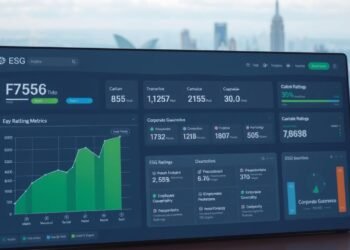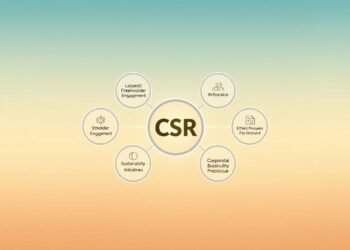What if your company’s future success depends less on financial metrics and more on how you treat the environment and your employees?
Today’s business landscape demands more than profit. Investors and stakeholders now evaluate companies through a broader lens. They want to see commitment to environmental responsibility, social equity, and ethical leadership.
This comprehensive framework helps organizations measure their impact beyond balance sheets. It creates transparency and accountability for organizational leaders. Companies must navigate various reporting requirements and disclosure frameworks.
Adopting these practices isn’t just about compliance. It’s about building long-term resilience and creating sustainable value. Businesses that embrace this approach often discover new opportunities and better risk management.
This guide will help you understand the evolving landscape. We’ll explore definitions, frameworks, regulations, and implementation strategies.
Key Takeaways
- Modern investors evaluate companies using environmental, social, and governance criteria
- Transparent reporting creates accountability and builds stakeholder trust
- Multiple frameworks exist for measuring non-financial performance
- Effective implementation can reveal new business opportunities
- Proper adoption helps manage risks and access new capital sources
- Regulatory requirements are increasing for US organizations
- Long-term business resilience depends on sustainable practices
Introduction to ESG and Its Growing Importance
Businesses today face a new reality where success extends beyond traditional financial metrics. The comprehensive evaluation framework known as ESG examines environmental impact, social responsibility, and governance practices. This approach provides a holistic view of organizational performance.
Stakeholder interest in corporate sustainability has surged dramatically. Investors, customers, and employees now demand greater transparency about business practices. This shift reflects changing societal values and expectations.
Recent research confirms this trend. Morgan Stanley’s 2025 survey revealed that 59% of individual investors plan to increase sustainable investments. This demonstrates growing investor commitment to responsible business practices.
Consumer preferences have evolved significantly. Nearly half of U.S. consumers reported purchasing environmentally friendly products in a 2025 GlobeScan survey. This preference directly impacts purchasing decisions and brand loyalty.
Corporate behavior also reflects this shift. An Omdia study found 94% of IT professionals would pay premium prices for sustainable vendors. This shows how sustainability factors into business-to-business decisions.
These factors have moved from niche concerns to mainstream business considerations. Modern markets increasingly connect non-financial performance with financial outcomes. Companies now recognize the strategic value of comprehensive evaluation.
Effective risk management now incorporates environmental and social considerations. Long-term business strategy must address climate issues and social responsibility. This approach helps identify potential challenges early.
The business case extends beyond regulatory compliance. Organizations discover new opportunities through sustainable practices. They often find improved operational efficiency and market positioning.
Maintaining competitive relevance requires adapting to evolving market expectations. Companies that embrace comprehensive evaluation frameworks position themselves for future success. They build resilience while creating lasting value.
What Are ESG Standards and Why Do They Matter?
Corporate reporting has evolved beyond financial statements to encompass environmental and social impacts. This transformation reflects growing stakeholder demands for comprehensive performance disclosure.
Understanding the distinction between frameworks and specific requirements is crucial for effective implementation. Each serves different but complementary purposes in sustainability measurement.
Defining ESG Standards vs. Frameworks
Frameworks provide principles-based guidance on how information should be structured. They offer flexible approaches to organizing sustainability data.
Specific requirements establish measurable benchmarks for what must be reported. They create consistency across organizations and industries.
This distinction helps companies translate broad concepts into tangible activities. It enables meaningful comparison of performance data.
The materiality assessment process identifies relevant topics for each organization. This ensures reporting focuses on issues that truly matter to stakeholders.
Standardized metrics enable comparability across different businesses. They help investors and other stakeholders make informed decisions.
Benefits of Adopting ESG Standards
Meeting stakeholder expectations builds trust and enhances reputation. Investors, customers, and employees increasingly value transparency.
Regulatory compliance becomes more manageable with established frameworks. Many jurisdictions are implementing mandatory disclosure requirements.
Risk management improves through systematic identification of environmental and social factors. This proactive approach helps prevent potential issues.
Performance benchmarking allows organizations to measure progress over time. It facilitates continuous improvement in sustainability practices.
Competitive advantage emerges when companies demonstrate leadership in responsible business. This can differentiate organizations in crowded markets.
Access to capital often improves with robust sustainability reporting. Many investors specifically seek companies with strong environmental and social performance.
Selecting appropriate frameworks depends on business objectives and stakeholder needs. Many organizations use multiple approaches for comprehensive coverage.
Framework interoperability ensures different systems work together effectively. This creates a holistic view of organizational performance.
Key ESG Reporting Frameworks and Standards
Multiple reporting systems have emerged to help companies measure and communicate their environmental and social performance. These frameworks provide structured approaches for organizations to disclose their sustainability efforts.
Each system offers unique benefits and focuses on different aspects of corporate responsibility. Understanding these differences helps businesses select the most appropriate tools for their needs.
Global Reporting Initiative (GRI)
The Global Reporting Initiative offers the most comprehensive sustainability reporting standard available today. It provides modular requirements that cover universal, sector-specific, and topic-oriented disclosures.
GRI addresses 34 distinct positive and negative impacts across environmental, social, and governance areas. This broad coverage makes it suitable for organizations of all types and sizes.
The framework’s modular design allows companies to tailor their reporting to specific industry contexts. Many global corporations use GRI as their primary sustainability reporting foundation.
Sustainability Accounting Standards Board (SASB)
SASB Standards take an industry-specific approach to sustainability disclosure. The system covers 77 different industries with tailored material issues for each sector.
This framework focuses on financially material sustainability information that impacts business performance. It helps investors understand how sustainability factors affect financial outcomes.
Companies appreciate SASB’s targeted approach that identifies the most relevant issues for their specific industry. This precision makes reporting more efficient and meaningful.
Task Force on Climate-related Financial Disclosures (TCFD)
TCFD provides a specialized framework focused exclusively on climate-related financial disclosures. The system organizes reporting around four core pillars: governance, strategy, risk management, and metrics/targets.
This structure helps companies communicate how climate issues affect their business operations and financial planning. Many organizations use TCFD alongside broader sustainability frameworks.
The framework has gained significant adoption among financial institutions and publicly traded companies. Its focused approach makes climate reporting more structured and comparable.
International Sustainability Standards Board (ISSB)
ISSB offers global baseline standards designed to create consistency in sustainability reporting worldwide. The system includes IFRS S1 for general sustainability disclosures and IFRS S2 for climate-specific information.
These standards incorporate elements from both SASB and TCFD frameworks. This integration creates a comprehensive approach to sustainability disclosure.
ISSB aims to establish a common language for sustainability reporting across global markets. The framework helps reduce complexity for multinational organizations operating in multiple jurisdictions.
Carbon Disclosure Project (CDP)
CDP operates an environmental disclosure system that uses detailed questionnaires and letter-grade scoring. The platform covers climate change, water security, and deforestation issues.
Companies complete integrated questionnaires that assess their environmental performance and management practices. CDP then assigns scores from A to D based on disclosure completeness and performance quality.
This scoring system provides clear benchmarks for environmental performance improvement. Many investors use CDP scores to evaluate companies’ environmental management practices.
Organizations often use multiple frameworks complementarily to create comprehensive reporting. The interoperability between systems, particularly GRI-ISSB alignment efforts, helps streamline disclosure processes.
Each framework has specific assurance and verification requirements that ensure data credibility. Companies should consider these requirements when planning their sustainability reporting strategy.
ESG Standards Regulatory Landscape in the United States
For the first time in US history, companies must comply with government-mandated environmental and social disclosure regulations. This represents a fundamental shift from voluntary reporting to required transparency.
The regulatory landscape now includes multiple overlapping requirements. Businesses must understand each regulation’s specific provisions and timelines.
California Senate Bills 253 and 261
California has taken a leadership role with two groundbreaking climate disclosure laws. These affect both in-state companies and those doing business in California.
SB 253 targets organizations with over $1 billion in annual revenue. It mandates comprehensive greenhouse gas emissions reporting across all three scopes.
Assurance requirements phase in gradually through 2030. Companies start with limited assurance before moving to reasonable assurance.
SB 261 applies to businesses exceeding $500 million in revenue. It requires biennial climate-related financial risk assessments.
Both laws carry significant penalty provisions. SB 253 allows penalties up to $500,000 for non-compliance.
SEC Proposed Climate Disclosure Rules
The Securities and Exchange Commission has proposed comprehensive climate disclosure requirements. These would affect all publicly traded companies.
The rules mandate climate-related information in financial statements. They require independent assurance for Scope 1 and Scope 2 emissions data.
Scope 3 emissions reporting depends on materiality assessment. Companies must evaluate whether these emissions significantly impact their business.
The proposed rules create consistency across corporate filings. They integrate climate considerations into traditional financial reporting.
Federal Supplier Climate Risks and Resilience Proposed Rule
Federal contractors face new sustainability reporting obligations. The proposed rule creates tiered requirements based on contract size.
Contractors with awards exceeding $7.5 million must report emissions. Major contractors must set science-based targets through the SBTi initiative.
This rule affects thousands of government suppliers nationwide. It represents the federal government’s commitment to supply chain sustainability.
Implementation timelines vary across these regulatory initiatives. Companies operating in multiple jurisdictions face complex compliance challenges.
These regulations mark America’s first mandatory corporate sustainability reporting requirements. They signal a new era of environmental transparency for US businesses.
Organizations must develop comprehensive compliance strategies. Cross-jurisdictional coordination becomes essential for multinational companies.
The assurance requirements progression demonstrates regulatory maturity. Limited assurance provides an initial phase before more rigorous reasonable assurance.
Materiality assessments under SEC rules allow company-specific determinations. This flexibility acknowledges different business models and impacts.
Penalty structures vary across regulations but emphasize compliance importance. Companies should prioritize understanding each requirement’s enforcement mechanisms.
International ESG Standards Affecting US Companies
Global sustainability regulations now reach across borders to impact American businesses. Many US organizations must comply with international reporting requirements alongside domestic rules.
Understanding these global frameworks helps companies navigate complex compliance landscapes. They create new opportunities while managing regulatory risks.
EU Corporate Sustainability Reporting Directive (CSRD)
The European Union’s sustainability reporting directive represents a comprehensive regulatory approach. It affects both EU-based companies and foreign organizations with significant European operations.
This directive uses a double materiality assessment approach. Companies must report both financial impacts and environmental/social effects.
Non-EU parent companies face requirements if they generate €150 million+ in EU turnover. This applies regardless of where the company is incorporated.
Approximately 3,300 US companies fall under these reporting obligations. They must comply with the European Sustainability Reporting Standards.
The ESRS framework includes 12 specific standards. These cover general requirements and detailed environmental, social, and governance topics.
Assurance requirements begin with limited verification. They progress to reasonable assurance over time.
IFRS Sustainability Disclosure Standards
The International Financial Reporting Standards Foundation created global baseline standards. IFRS S1 covers general sustainability disclosures while IFRS S2 addresses climate-specific information.
These standards incorporate elements from established frameworks. They integrate TCFD recommendations and SASB Standards.
Adoption remains voluntary unless jurisdictions mandate compliance. Multiple countries are currently considering implementation.
Australia, Canada, and Japan are among nations evaluating these standards. The UK, Singapore, and Malaysia are also reviewing adoption.
Assurance requirements depend on individual jurisdiction decisions. Each country determines its verification approach.
Interoperability efforts help these standards work with other frameworks. The alignment between ESRS and IFRS reduces reporting complexity.
Global harmonization efforts continue to evolve. Companies should monitor developments across multiple jurisdictions.
How to Choose the Right ESG Standards for Your Business
Selecting the appropriate reporting framework requires careful consideration of multiple factors. Companies must balance stakeholder expectations with practical implementation needs.
The right choice depends on your industry, size, and strategic goals. A thoughtful approach ensures meaningful reporting rather than just compliance.
Assessing Industry Relevance and Stakeholder Expectations
Begin with a materiality assessment to identify your most important topics. This process pinpoints issues that matter to your business and stakeholders.
Industry-specific factors greatly influence framework selection. Manufacturing companies face different environmental challenges than technology firms.
Financial services organizations prioritize governance and social metrics. Consumer goods companies focus more on supply chain and product sustainability.
Map expectations from all key stakeholder groups. Investors typically want climate risk data and diversity metrics.
Customers care about product sustainability and ethical sourcing. Employees value workplace safety and inclusion practices.
Regulators require specific disclosures based on jurisdiction. Communities want information about local environmental impacts.
Evaluating Framework Compatibility and Interoperability
Consider how different systems work together before making selections. Many organizations use multiple frameworks to address various needs.
Evaluate the purpose alignment of each option. Some frameworks focus on investor needs while others address broader stakeholders.
Check industry suitability through sector-specific guidance. Certain standards offer tailored metrics for particular industries.
Assess stakeholder credibility by examining adoption rates. Widely recognized frameworks carry more weight with investors.
Review factor coverage to ensure comprehensive reporting. Some systems emphasize environmental issues while others cover social topics.
Analyze regulatory environment requirements in your operating regions. Compliance often dictates certain framework choices.
Consider implementation resources needed for each option. Data collection and reporting demands vary significantly.
Create a selection matrix based on your specific business objectives. This helps compare frameworks against your priority criteria.
Many companies successfully implement complementary frameworks. This approach addresses different stakeholder needs comprehensively.
Implementing ESG Standards: A Step-by-Step Approach
Successful implementation begins with a clear roadmap that transforms theoretical frameworks into operational reality. Organizations must develop systematic approaches that integrate sustainability into core business operations.
This process requires careful planning and cross-functional collaboration. Companies need to establish clear governance structures and allocate appropriate resources.
Data Collection and Management Strategies
Effective data gathering forms the foundation of credible corporate sustainability reporting. Organizations must identify relevant metrics based on their industry and stakeholder expectations.
Primary data collection involves direct measurement of environmental impacts. This includes energy consumption, greenhouse gas emissions, and water usage tracking.
Secondary data estimation techniques help fill gaps where direct measurement isn’t feasible. Many companies use industry averages or calculated estimates for certain metrics.
Technology solutions dramatically improve data accuracy and efficiency. Specialized software platforms automate data collection from multiple sources.
ERP integrations allow seamless data flow between financial and sustainability systems. This reduces manual entry errors and improves reporting consistency.
Validation processes ensure data quality throughout the collection cycle. Regular audits and verification checks maintain information integrity.
Audit trail maintenance creates transparency for external assurance requirements. Proper documentation supports verification processes.
Integration with Existing Business Processes
Successful implementation requires embedding sustainability into daily operations. Companies should align new requirements with established business processes.
Financial reporting integration creates consistency between traditional and sustainability disclosures. This approach helps investors see the complete performance picture.
Risk management systems should incorporate environmental and social factors. This holistic view improves overall risk assessment accuracy.
Procurement processes need updated vendor selection criteria. Sustainable sourcing becomes part of supplier evaluation metrics.
HR systems must track diversity, equity, and inclusion metrics. Employee satisfaction and safety data become part of regular reporting.
Executive sponsorship ensures organizational commitment to implementation. Cross-functional teams bring diverse perspectives to the process.
Change management approaches help employees adapt to new reporting requirements. Training and communication support smooth organizational adoption.
Performance tracking systems monitor progress against sustainability goals. Regular reporting cycles maintain momentum and accountability.
Implementation timelines vary by company size and complexity. Small businesses might complete initial implementation in 6-12 months.
Larger organizations often require 18-24 months for full integration. Resource allocation should match the scope of implementation activities.
Continuous improvement processes ensure ongoing program management. Regular reviews identify opportunities for enhancement and refinement.
Assurance and Verification of ESG Reporting
Independent verification builds trust in your corporate sustainability disclosures. This process confirms the accuracy and reliability of reported information.
Third-party assurance provides credibility to stakeholders. It demonstrates your commitment to transparent and accountable reporting practices.
Understanding Assurance Requirements
Assurance levels vary based on regulatory frameworks and stakeholder expectations. Limited assurance offers moderate confidence through analytical procedures and inquiry.
Reasonable assurance provides high confidence through detailed testing and evidence examination. This level resembles financial statement audits in rigor and scope.
Major regulations typically start with limited assurance requirements. They gradually transition to reasonable assurance over implementation periods.
California’s SB 253 follows this progression pattern. Companies begin with limited assurance before moving to reasonable assurance by 2030.
Materiality thresholds determine which disclosures require verification. Providers apply professional judgment to assess significance levels.
Tolerance levels help determine acceptable error ranges. These vary based on the nature of disclosed information and stakeholder needs.
Selecting Verification Providers
Companies can choose from several types of assurance providers. Big Four accounting firms offer comprehensive sustainability verification services.
Specialized firms focus exclusively on environmental and social reporting verification. They bring deep expertise in specific frameworks and metrics.
Certification bodies provide industry-specific assurance services. These organizations understand unique sector challenges and opportunities.
Selection criteria should include framework expertise and industry experience. Providers must understand your specific reporting requirements.
Independence credentials ensure objective verification opinions. Cost structures should align with your assurance needs and budget constraints.
The assurance process involves several key stages. Planning establishes scope, objectives, and methodology.
Testing examines evidence supporting reported information. Evaluation assesses whether disclosures fairly represent performance.
Opinion formulation provides the final assurance conclusion. This statement appears in your sustainability report.
Documentation requirements support the verification process. Companies must maintain evidence for all disclosed metrics and information.
Data quality issues present common assurance challenges. Estimation methodologies require particularly careful examination and validation.
Internal preparation involves process documentation and control evidence. Teams should understand verification requirements before engagements begin.
Response planning addresses potential findings and recommendations. Implementation of improvements demonstrates commitment to continuous enhancement.
Effective assurance partnerships create value beyond compliance. They identify opportunities for reporting process improvements and performance enhancements.
Future Trends in ESG Standards and Reporting
Technology and regulation are reshaping how organizations measure and communicate their impact. These changes create new possibilities for transparency and performance improvement.
Companies must stay ahead of evolving expectations. Understanding emerging trends helps businesses prepare for future requirements.
AI Integration in ESG Data Analysis
Artificial intelligence transforms how organizations handle environmental and social information. It automates complex data collection from multiple sources.
Machine learning algorithms identify patterns in large datasets. They help predict future performance based on historical trends.
Natural language processing monitors regulatory changes across jurisdictions. This keeps companies informed about new requirements.
Computer vision technology assists with supply chain monitoring. It verifies environmental practices through image analysis.
Predictive analytics connect sustainability metrics to financial outcomes. This helps investors make better decisions.
Automated benchmarking compares performance against industry norms. Companies can identify areas for improvement.
Real-time data processing enables immediate response to issues. This improves risk management capabilities.
Regulatory Developments and Global Harmonization
International efforts create consistent reporting requirements across borders. The ISSB leads this harmonization movement.
Global baseline standards reduce complexity for multinational organizations. They help companies operate in multiple markets.
Reporting scope expands beyond climate concerns. New frameworks address biodiversity loss and social equity.
Value chain reporting becomes increasingly important. Companies must account for impacts throughout their operations.
Mandatory requirements replace voluntary disclosure regimes. Regulations now compel transparency rather than encourage it.
Double materiality assessments evolve to include dynamic approaches. This ensures reporting remains relevant over time.
Emerging technologies like blockchain verify data authenticity. Internet of Things devices provide real-time environmental monitoring.
Integration with financial reporting creates comprehensive performance pictures. Investors receive complete information for decision-making.
New metrics address contemporary challenges like AI ethics and circular economy principles. Reporting frameworks continue evolving to meet changing needs.
Conclusion
Companies today operate in a rapidly changing landscape where environmental and social performance matters. Organizations must adapt to new rules from California, the SEC, and international bodies.
Investors and customers now expect transparent disclosure of sustainability efforts. This shift creates both challenges and opportunities for businesses of all sizes.
Proactive preparation is essential for long-term success. Start with a materiality assessment to identify key issues. Then select appropriate frameworks and build data collection systems.
Leadership commitment drives meaningful progress. Integrated approaches help address multiple requirements efficiently.
Beyond compliance, these practices build resilient organizations. They create value while managing risks in evolving markets.
Begin your journey today regardless of current mandates. Continuous improvement ensures readiness for future developments.
FAQ
What are ESG standards?
ESG standards are specific, measurable guidelines that help companies report on environmental, social, and governance performance. They provide a consistent way to share data with investors, regulators, and other stakeholders.
Why do ESG standards matter for businesses?
These standards help organizations manage risks, identify opportunities, and build trust. They also support better decision-making and can improve long-term business value.
How do ESG standards differ from frameworks?
Standards offer specific metrics and disclosure rules. Frameworks provide broader principles or structures for reporting. Many companies use both to guide their sustainability efforts.
Which ESG standards are most widely used?
Common standards include those from the Global Reporting Initiative, SASB, TCFD, and ISSB. The Carbon Disclosure Project is also a key platform for climate-related disclosures.
Are US companies required to follow ESG reporting rules?
Requirements are growing. California has passed new laws, and the SEC has proposed climate disclosure rules. Federal suppliers may also face climate risk reporting mandates.
Do international standards affect US businesses?
Yes. Regulations like the EU Corporate Sustainability Reporting Directive can impact US companies operating in global markets. Many are also adopting IFRS Sustainability Disclosure Standards.
How should a company choose the right standards?
Businesses should consider their industry, stakeholder expectations, and how well different standards work together. Alignment with material topics is key.
What is involved in implementing these standards?
Implementation includes data gathering, integrating reporting into business processes, and often seeking external verification for accuracy and credibility.
Is third-party verification necessary for ESG reports?
While not always mandatory, assurance enhances report reliability. Many investors and regulators expect or require verified disclosures.
What future trends will shape ESG standards?
Trends include greater use of artificial intelligence in data analysis, more regulatory clarity, and efforts toward global alignment of disclosure requirements.







